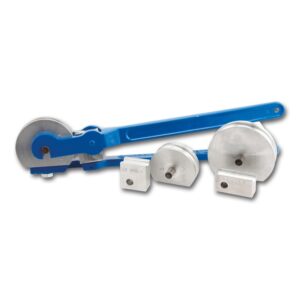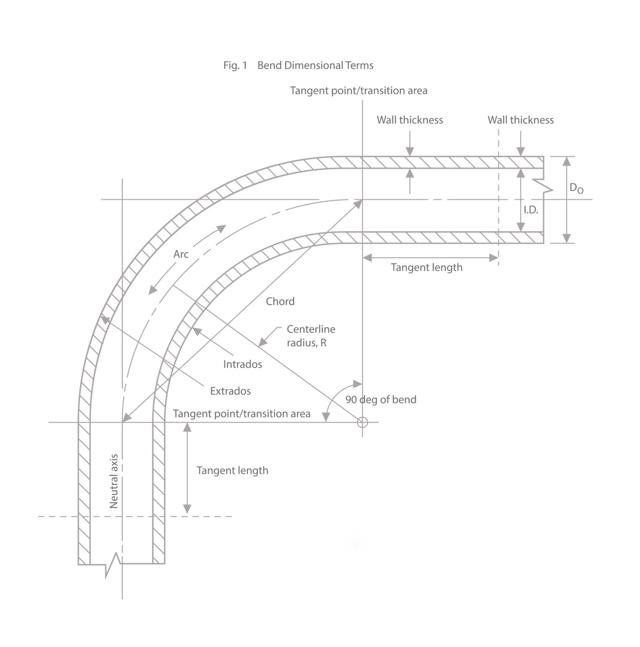Our Location
Bending is the primary and most common technology for shaping tube parts, although it is usually associated with shaping flat items. Previously, hand-bending was time-consuming and often resulted in incorrectly dimensioned tubes. Technology has advanced so that specialists no longer rely on outdated techniques to bend tubes. The guides below are essential reading if you need clarification on your tube’s bending requirements.

Table of Contents
ToggleTube bending, or precision tube bending, is a mechanical process that involves deforming tubes using a bending method to transform straight tubes into curved shapes. Tubes created through the tube bending can be made from various metals and alloys, as the process is not limited to any specific material. There are numerous options for bending a tube, each with its benefits, disadvantages, and cost considerations.
Bending metal tubing is essential in many industries for various applications. Here are some reasons why metal tubing needs to be bent:
Bent tubing’s flexibility makes it ideal for applications where straight tubing is not suitable, such as tight or confined spaces.
Metal tubing is often customized to fit a specific design or purpose, and bending allows us to achieve the necessary shape and size.
Bent tubing provides fluid systems with precise control of liquid or gas flows, directing them exactly where needed.
Bent tubing offers crucial structural support and strength, making it essential in construction and automotive manufacturing.
Tubing must often be bent to create specific components like handwheels or exhaust systems for uniqueness.
Bent steel tubing is widely used for its aesthetic value in architectural and design applications, creating unique structures with visually appealing systems.
Bending metal tubing provides flexibility, adaptability, and functionality for various industrial and design needs.
Tube bending machines come in various types, such as press benders, rotary draw benders, and roll benders. The primary function of these machines is to create a curved tube by applying pressure on a metal tube, which results in bending the tube at a precise angle.
Tube bending is crucial in various industries, including manufacturing, automobile, and aerospace. It involves using different techniques to achieve specific shapes and angles, each with advantages and ideal applications. Different types of tube bending methods are as follows:
Roll Bending is a tube bending method that uses a three or four-roll machine, also known as an Angle Roll or Section Roller. The machine pulls the tube or pipe through the rolls while pressing it into an increasing bend. This method is similar to press bending, using a triangular pattern of support rollers and pressing rollers. However, unlike Press Bending, Roll Bending can bend various angles using the same rollers. The tube or pipe moves through the bending sequence by the powered and turning rollers. This method is an easy and precise way to bend various radii without needing specific tooling for the desired bend radius.
Roll Bending Advantage and Disadvantage
Roll bending creates tube radii and forms pipes, bars, and angles. However, it is a slow process that can result in inaccurate and inconsistent results, especially with thin-walled tubing.

Rotary Draw Bending faces the challenge of maintaining a pipe’s diameter through bends. Compression bending machines may not produce complex bends and can cause irreversible deformities. Rotary draw bending provides greater accuracy with tubing bending parts, allowing pipes to feature sharp bends while meeting high levels of precision and consistency. It is often used when fabricating tubing parts for machines or structural frameworks.
Rotary Draw Bending Advantage and Disadvantage
Rotary Draw Bending is precise, repeatable, and fast, making it ideal for high-volume production. However, the machinery is less flexible and requires costly tooling for each tube/pipe diameter and radius formed.

Compression bending is a technique that involves applying force against a pipe material to achieve deformation, making it one of the easiest forms of pipe bending. It is commonly used to manufacture electrical conduit pipes with simple bend formations. The compression bending process typically consists of five components: bend die, clamp die, pressure die, wiper die, and mandrel. The bend dies, or mold component, apply pressure on pipe specimens to shape them into their desired form. Other tools, such as clamp die and wiper die, support fabrication in place and prevent defects in the material as the process continues. Although mandrels can be seen on compression bending machines, their usage in the mandrel tube bending process will become apparent later.
Compression Bending Advantage and Disadvantage
Simple tooling can adapt to existing machinery for cheap processing. It’s versatile for bending tubing and pipes.
However, the tubing is prone to crushing easily, which affects its durability. The accuracy and repeatability of the product are poor, leading to inconsistencies in its performance. The production process is very slow, which can result in delays and increased costs.
Mandrel tube bending is a process that involves using a flexible mandrel rod inserted into the tube while it’s being formed. It allows the tube to conform to its contours comfortably as it changes shape. The use of mandrels helps rotary bending machines bend the material consistently without damaging or warping it over time.
Mandrel Tube Bending Advantage and Disadvantage
Mandrel bending offers accuracy, repeatability, and shape retention. A mandrel is inserted into the tube during bending to support it and prevent deformation. This method is relatively fast but can be costly due to the need for specialized equipment and setup time.

The tube bending process mainly includes the following steps:
1. Conducting the Production Instruction, every process should follow the instructions strictly.
2. Selecting the Tube Material: The first important decision in the tube bending process is selecting the ideal material for the tube. The specific application dictates the material choice, ranging from steel and aluminum to copper and more, each offering different properties.
3. Measuring and Marking: Precision is crucial in tube bending. Measurements are taken to determine the appropriate location where the bend needs to occur. Marking the tube ensures that the bending is done accurately and according to the design specifications.
4. Preparing the Tube: The tube ends may need preparation to ensure a smooth and even surface. It helps prevent damage during bending and ensures that the final product meets quality standards.
5. Decide on the bending method: Different tube bending methods exist, each with advantages and applications. The specific method, such as mandrel bending, rotary draw bending, compression bending, or roll bending, is selected based on the project’s requirements, including the bend’s angle and radius.
6. Securing the Tube: The tube is securely clamped into a bending machine or fixture to ensure it stays in place during the bending process. Proper clamping is essential to avoid slippage and unwanted deformation.
7. Bending Angle and Radius Configuration: The operator configures the bending machine to achieve the desired bend angle and radius. It is crucial to align the machine precisely with the marked point on the tube to ensure accurate results.
8. Bend Process Operation: The bending process is initiated with the tube in place and the machine configured. The machine applies controlled force to the tube, reshaping it to meet the predetermined specifications. Careful execution is essential to achieve the desired bend without damaging the tube’s structural integrity.
9. Checking Defections: After the tube is bent, a close inspection is carried out to detect any imperfections, such as cracks, wrinkles, or deformities. Identifying and addressing issues is critical to ensuring the tube’s structural integrity and quality.
10. Post-Bend Techniques: Additional post-bending techniques may be required depending on the specific application. It can involve welding, end forming, assembly, or other secondary operations that prepare the tube for its intended use.
11. Inspection: Quality control is crucial to the tube bending. A final inspection is conducted to ensure that the bent tube aligns with the desired specifications and meets the established quality standards.
12. Packing: The quality of packing is crucial to prevent damage to the surface and maintain its shape.
Many materials are suitable for tube bending. Below are examples:
Different materials require different tools and methods for bending, such as manual bending, press bending, pliers, bending machines, etc. When performing bending operations, consider material thickness, length, angle, and the selection of bending methods.
Tube bending is a versatile manufacturing system used in various industries as below:
1. Aerospace Industry: Tube bending creates lightweight yet robust components, frames, and structural factors.
2. Automobile Industry: Tube bending is critical for exhaust, chassis, and body structures.
3. Manufacturing Industry: Tube bending is used in components of conveyor systems and industrial equipment.
4. Architectural Industry: Tube bending enhances structure and aesthetics and is used in handrails, curved facades, and metalwork.
5. Medical Industry: Tube bending ensures the safe and precise distribution of medical gases and the creation of wheelchair frames.
6. New Energy Industry: Tube bending is used in components of the carrier rails, frame, and back rails in solar power industry

Tube bending is a specialized production process that requires specific machinery and systems to reshape tubes effectively. We outline the following equipment used in tube bending and explain why selecting the right equipment is crucial for specific programs.
Three types of tube benders are hand-operated, semi-automatic, and CNC. Hand-operated tube benders are ideal for small-scale tasks and easy bends, making them perfect for workshops or DIY enthusiasts. Semi-automatic tube benders use both manual and hydraulic operation for greater precision and efficiency in tube bending. They are commonly found in mid-sized production settings. CNC tube benders are highly automated devices that can bend tubes to precise specifications, making them ideal for high-volume production lines and precision-oriented software.

Dies and tooling are essential in achieving preferred bend angles and shapes without deforming or imperfections in the tubing. Mandrels are vital tools that preserve the internal diameter of tubes during bending to avoid wrinkles or collapsing of the tube’s inner diameter within this operation. Wiper dies can be used to remove wrinkles on the surface of bent tubes, making them appear modern. Bend dies are available in many sizes and styles to produce diverse bend angles and radii; therefore, finding one for the preferred result results in manufacturing the required bend in a tube.
Hydraulic tube benders depend upon hydraulic power units to generate the force necessary to bend tubing accurately and consistently. Therefore, this hydraulic device’s ability and control are vital to produce steady bends.
Clamps and supports are used to keep the tube in place during bending operations, preventing slippage or undesirable deformation. Numerous designs of clamps are available for this purpose, such as adjustable clamps or vice grips.
Specific measurements and markings are essential for developing accurate bends. Calipers and protractors allow us to measure and mark tubing at its exact points where bending occurs, giving us more precise angles.
Choosing the proper tube bender dies and tooling, hydraulic structures, clamps and supports, and measuring and staining tools is crucial in meeting task requirements effectively. This option system guarantees precision, repeatability, and speed by selecting the right equipment.
Quality tube bending components are crucial in various fields, and their consistency and quality are essential. The following procedure is used to ensure that the tube-bending components are of the highest quality.

It is crucial to check the quality and specifications of any tubing or pipes you want to use. During fabric inspection testing, cracks or irregularities in the material can trigger an alarm. Finished goods’ structural integrity and quality depend on careful material selection and thorough examination.
Properly maintained bending equipment, including tube benders powered by computer Numeric Controlled Management (CNC), is key to maintaining precision and accuracy throughout the bending process. CNC tube benders offer enhanced management and automation features to minimize errors while increasing repeatability and productivity. Quality equipment ensures the bending system is regular and the final components meet the desired specifications.
The selection and protection of tooling and dies play a widespread role in excellent manipulation. Right tooling ensures that bends are made precisely, without deformations or surface imperfections. Normal renovation of dies and tooling is vital to avoid wear and tear that may cause versions to bend exceptionally.
The usage of mandrel and wiper dies is not unusual in tube bending. Mandrels preserve the internal diameter of the tube, preventing deformations or wrinkles. Wiper dies reduce surface imperfections and improve the aesthetics of the completed element. Employing the right mandrel and wiper die and ensuring the right maintenance is essential for generating bends.
Tube bending is an essential process, and it is necessary to follow specific standards to ensure the quality of the final product. The most commonly used tube bending standards in practical engineering are ASTM and JIS, which regulate tube bending performance, size, manufacturing process, and other aspects.
![]()
When bending tube, it is crucial to comply with the following standards:
1. The bending angle of the elbow should not exceed the standard angle’s deviation range.
2. The tube wall must be free of visible cracks, and the depth of any cracks should not exceed 10% of the thickness.
3.The tube wall should be smooth to ensure proper flow.
4. The tubes should be kept stable while bent to avoid excessive deformation, and breaking the tubes or detaching the elbows is strictly prohibited.
To inspect the quality of the tube bending process, the following methods can be used:
1. Appearance inspection: Inspect the appearance of the elbow, including issues such as bending angle, tube wall cracks, wrinkles, etc. If defects are found, production should be stopped immediately, and repairs should be carried out.
2. Ultrasonic testing: Ultrasonic testing can detect defects and changes in thickness inside the elbow. Ultrasonic testing is more important for high-pressure, large-diameter, and large-diameter elbows.
3. Radioactive testing: Radioactive testing is mainly used to inspect large-diameter, medium-thick wall elbows, and high-strength steel elbows to detect welding quality and defects in tube walls.
When selecting tube materials, it is essential to consider factors such as the purpose of the tube, conveying medium, working environment, pressure, temperature, etc. Choosing materials produced by reputable manufacturers to ensure engineering quality is also crucial.
In summary, tube bending must comply with standards and be strictly inspected to ensure project quality. Choosing appropriate tube materials is also an essential guarantee for ensuring engineering quality.
Tube bending has undergone significant changes over the years, and there is a lot to learn about the different types of tubes and the bending process. This article covers every aspect of tube bending, including the common materials, applications, and equipment. If you have questions, please contact us for a prompt reply.

